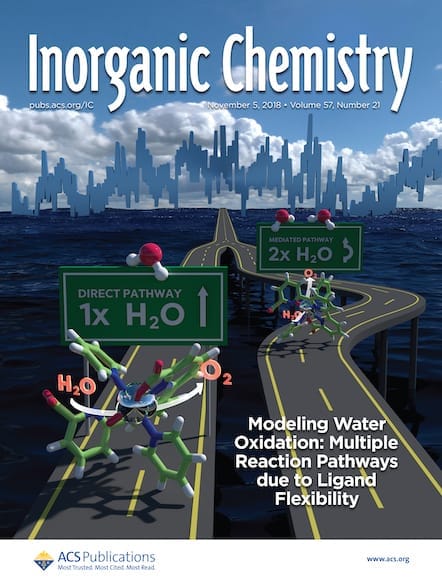The Inorganic Chemistry and Organometallics editorial teams are excited to welcome a total of three new Associate Editors: Stefanie Dehnen, Philipps University Marburg, Inorganic Chemistry Kathrin H. Hopmann, UiT–The Arctic University of Norway, Organometallics Roberta Sessoli, University of Florence, Inorganic Chemistry Inorganic Chemistry Associate Editor Stefanie Dehnen Stefanie Dehnen is Professor of Inorganic Chemistry and […]

The Inorganic Chemistry and Organometallics editorial teams are excited to welcome a total of three new Associate Editors:
- Stefanie Dehnen, Philipps University Marburg, Inorganic Chemistry
- Kathrin H. Hopmann, UiT–The Arctic University of Norway, Organometallics
- Roberta Sessoli, University of Florence, Inorganic Chemistry
Professor Dehnen obtained her diploma in 1993 and her doctoral degree in 1996 from the University of Karlsruhe under the supervision of Dieter Fenske on experimental and theoretical investigations of copper sulfide and selenide clusters. After a postdoctoral stay with Reinhart Ahlrichs in the Theoretical Chemistry Department at Karlsruhe, she completed her Habilitation at Karlsruhe in 2004, investigating the chemistry of chalcogenostannate salts.
Among her professional honors, Professor Dehnen was awarded the 2004 Wöhler Young Scientists Award from the German Chemical Society (GDCh) and a 2005 Heisenberg Fellowship from the German Research Foundation (DFG). From 2016 she has been an elected member of the Göttingen Academy of Sciences and Humanities and the Academy of Sciences and Literature, Mainz. Professor Dehnen is currently an elected member of the GDCh Board of the Division for Inorganic Chemistry and the DFG Review Board for Molecular Chemistry. When not thinking about chemistry, Professor Dehnen is an accomplished violinist and enjoys time with her family.
“As an inorganic chemist, I am thrilled by the chance and ability to create new molecules by systematic variation of elemental combinations that haven’t been realized on the molecular level so far, as this allows us to find and control new functional properties of the compounds,” says Professor. Dehnen. “I hope my contribution to Inorganic Chemistry will be threefold: First, I want to be an efficient and fair Editor; second, I want to help identify and bring in new authors and promote new branches of inorganic chemistry being published in this excellent journal; and third, I want to be creative in helping develop ideas for Special Issues and innovative publication formats.”
Her group applies computational and experimental tools to elucidate the mechanistic intricacies of chemical reactions, with a focus on the factors that govern the activity and selectivity of transition-metal-catalyzed transformations. Assoc. Professor Hopmann spends her free time with her two children, with whom she lives on a beautiful island above the Arctic Circle, she relates, where the sun never sets in summer and never rises in winter, though this is compensated for by the dancing Northern Lights in the sky.
“I wish to use my expertise in the field of computational modeling together with my enthusiasm for organometallic chemistry to promote Organometallics as a cutting-edge journal for experimental and computational contributions on organometallic, inorganic, and organic chemistry,” Assoc. Professor Hopmann says. “Nowadays, computations are increasingly being applied to explain the properties and behaviors of chemical compounds. I hope to attract high-quality submissions of combined computational and experimental studies, where these disciplines are allowed to shine together to rationalize and even predict the behavior of organometallic systems.”
Professor Sessoli obtained her Ph.D. in Chemistry in 1992 at the University of Florence working on low dimensional molecular magnetic materials with Professor Dante Gatteschi and performing part of her studies at the Institute of Fundamental Electronics at the University of Paris South with Dr. Jean-Pierre Renard. She joined the University of Florence as an Associate Professor in 2000 and became Full Professor in 2012. Professor Sessoli is a research associate of CNR-ICCOM and a member of Academia Europea and the Italian Accademia dei Lincei.
She has been awarded a visiting professorship at Gutenberg University in Mainz (2018-2019) and is a member of the Scientific Council of the Italian Chemical Society.
For her scientific achievements, Professor Sessoli has been selected as a member of the Science & Technology Advisory Council of the President of the European Commission (2013-2014), and she has received the IUPAC Distinguished Woman in Chemistry Award (2015), the Lecoq de Boisbaudran Award from the European Rare Earths Society (2015), and the Agilent Technologies Europhysics Prize (2002). In her spare time away from the lab, she likes reading and enjoys running.
“Chemistry, especially coordination chemistry, attracted my attention because it allows me to develop in a creative way my passion for physics and more specifically for magnetism–spin is a fundamental property of matter that governs many phenomena,” Professor Sessoli observes. “With my service to Inorganic Chemistry, I hope to strengthen the connections between coordination chemistry, physics, material science, and nanotechnology.”
